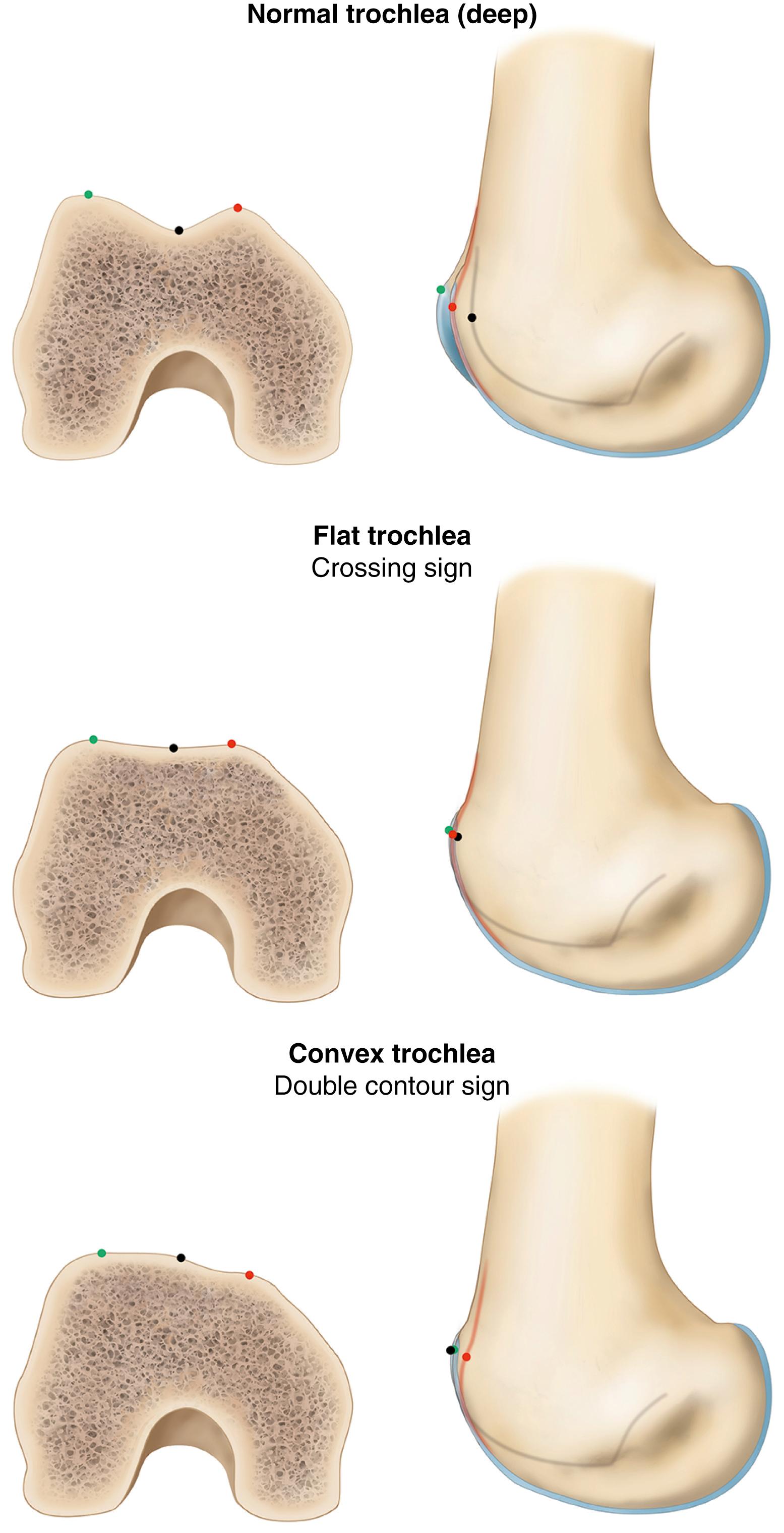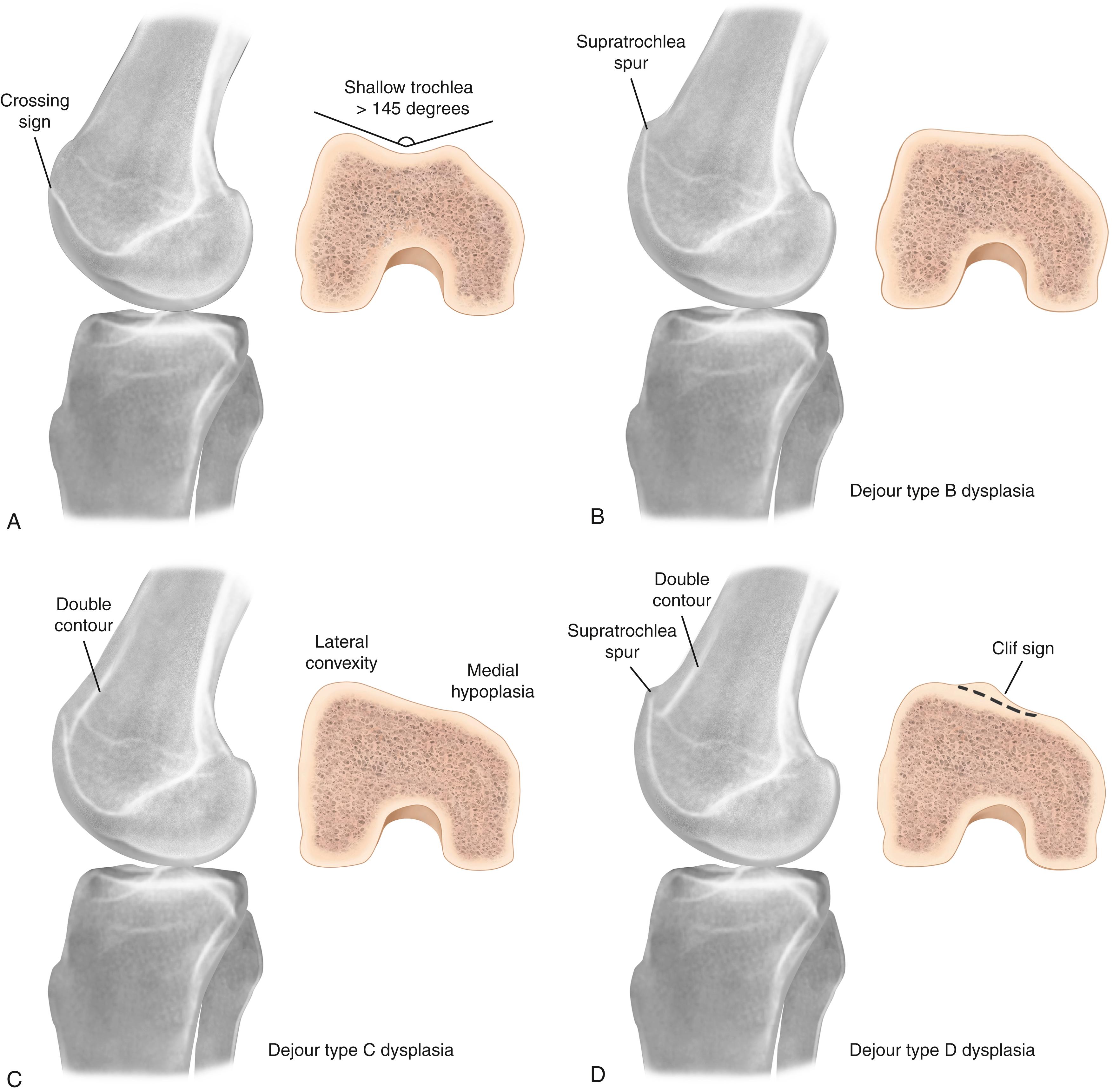Physical Address
304 North Cardinal St.
Dorchester Center, MA 02124
Patellofemoral instability (PFI) is a complex condition with multiple contributing factors. There is increasing evidence to suggest that one of the most important factors causing PFI is the presence of trochlear dysplasia (TD). , Although TD is present in less than 2% of the general population, it has been found in up to 85% of patients who have recurrent instability of their patella. Surgery is often required to stabilise the patella in these patients who are at high risk for chondral injury associated with recurrent instability episodes. TD represents an abnormally flat, shallow, or convex anterior distal femur, in contrast to the normally concave trochlea groove ( Fig. 32.1 ). In 1964 Brattström described TD by defining three types of abnormal trochlea sulcus angles. More recently, Dejour et al. published the classification system that is most widely used today based on the evaluation of lateral and axial radiographs. They identified four grades of TD: Type A represents a shallow sulcus, type B as a flat trochlea, type C as a hypoplastic medial trochlear facet and type D as hyperplastic or convex shaped trochlea.

The sulcus-deepening trochleoplasty (TP) is a surgical procedure to correct TD that removes subchondral bone and restores the concave anatomy by deepening the trochlear groove. The first description of TP can be traced back to the late 1800s, when Pollard described the distal femur as ‘ill-shaped’ and corrected it with open surgery. Since Pollard’s description in 1891 there have been several technique changes and advancements in surgical techniques. There are now two commonly performed surgical TP techniques: thin flap and thick flap. The thick-flap technique was introduced by Masse in 1978 and later modified by Dejour. The thin-flap technique was proposed by Bereiter in 1994 and has also been developed into an arthroscopic technique by Blønd and Schöttle.
The trochlea lies at the distal anterior aspect of the femur and is composed of two facets (medial and lateral) and a trochlear groove. , The two facets are asymmetrical and straddle the central trochlear groove. The lateral facet is both wider and more prominent than the medial facet. In the normal knee the trochlear groove deepens more distally and deviates slightly lateral relative to the anatomical axis of the femur. , , The depth of the trochlear groove in relation to the highest points on the medial and lateral facets is known as the sulcus angle and in normal individuals averages 138 ± 6 degrees. TD may occur as a result of an abnormality of the entire trochlea or more focal anatomical variations. The end result is a shallow, flat or convex trochlear groove, typically caused by either subchondral bony malformation in the central groove, underdeveloped facets or a combination of both. The bony prominence of the trochlear groove will result in an increased sulcus angle. By definition, TD is present when there is a shallow trochlear groove with a sulcus angle of 145 degrees or more. , The aetiology behind the dysplastic development of the trochlea is still unknown and different theories have been proposed, such as genetic predisposition or breech presentation of the foetus. ,
There are two primary types of patellofemoral stabilisers: soft tissue and osseous. The medial patellofemoral ligament (MPFL), medial and lateral retinacula and quadriceps muscle comprise the main soft tissue stabilisers for the patella. The bony restraint relies on the anatomical relationship between the patella and the trochlea being analogous to a ball-and-glove or lock-and-key pairing, in that the patella is normally stable within the groove as a result of the matching osseous and cartilaginous anatomy. Although these components all influence patella tracking and the potential for instability, the most powerful factor is the osseous anatomy. ,
The stability of the patella also changes throughout knee range of motion (ROM). Starting in full extension, during the first 20 degrees of knee flexion the MPFL is not under tension and the patella is not fully engaged in the trochlear groove. This makes the patella vulnerable to dislocation forces throughout this range. In the normal knee the patella first contacts the trochlea laterally, and the patella is translated medially approximately 5 mm through the first 20 degrees of flexion. As flexion is further increased, the patella becomes fully engaged in the trochlea and the patella follows the course of the groove distally and laterally. This results in lateral patellar translation of 11.5 mm at 90 degrees of knee flexion, relative to the position of the patella in full extension. The quadriceps muscle acts as a dynamic patella stabiliser, and its effects are greatest between 30 to 90 degrees of flexion, with minimal contribution to stability during the first 30 degrees. In deep flexion the patella is stabilised by the depth of the trochlea and by the posterior pull of the quadriceps. ,
The first step in the evaluation of a patient presenting with patella instability is a detailed history because this can provide useful information guiding the management options for PFI. Patients can be stratified into those with acute first-time dislocation, recurrent instability or primarily patellofemoral pain. Mechanical symptoms such as locking or catching of the patella may suggest chondral injury and possible loose bodies. A history of other joint instabilities may suggest an underlying collagen disorder or generalised ligamentous laxity. Additionally, an increased risk of recurrent instability has been associated with younger age, skeletal immaturity, contralateral patellar dislocation, family history of patella dislocation and history of developmental dysplasia of the hip.
Physical examination may be limited after an acute dislocation because of pain and apprehension, and patients may require repeat evaluation after 1 week of immobilisation. In this acute phase it is important to rule out more severe pathological conditions such as ligament disruption, meniscus injury, osteochondral injury and neurovascular injury. A large knee effusion may suggest osteochondral injury, and a therapeutic arthrocentesis can be considered to allow better assessment of patella tracking. Pain along the MPFL, increased patella translation and a positive apprehension sign (guarding with a lateral translation force applied to the patella) are all signs of PFI. The apprehension test has been reported to have an accuracy of 94%, with 100% sensitivity, 88% specificity and positive and negative predictive values of 89% and 100%, respectively. A tight lateral retinaculum may also contribute to PFI and is heralded by fixed lateral patellar tilt. Patellar maltracking may also be accompanied by a J-sign in which the patella subluxates laterally in extension and reduces into the trochlear groove with flexion. The J-sign is often present in the setting of TD.
Imaging is a crucial adjunct in the objective assessment and classification of TD. The most commonly used classification system is that introduced by Dejour et al., which can be used to classify TD on the basis of lateral and axial imaging ( Fig. 32.2 ). The three findings on lateral radiographs that suggest TD are the crossing sign (Dejour types A through D), supratrochlear bump/spur (type B) and a double contour line (type C). The presence of all three signs suggests severe (type D) TD. The crossing sign is present when the trochlear groove becomes shallow (>145-degree sulcus angle) and the corresponding radiographic line crosses the anterior border of the femoral condyles on a lateral radiograph. The superolateral trochlea creates the supratrochlear spur, and asymmetry between the medial and lateral trochlear facets causes the double contour sign. This sign is most often associated with a hypoplastic medial facet.

Advanced imaging with magnetic resonance imaging (MRI) is often recommended in the initial evaluation of PFI. Computed tomography (CT) provides less information on the soft tissue and cartilaginous structures and confers radiation exposure, making MRI the imaging modality of choice in the absence of significant bony pathology. Axial MRI is particularly useful for evaluation of TD because the trochlear groove, trochlear facets and patella position are well visualised and the sulcus angle, lateral trochlear inclination and tibial tubercle–trochlear groove (TT-TG) distance can be calculated. ,
Nelitz et al. proposed an arthroscopic classification of TD. They described two types of dysplasia, a flat trochlea (type 1) and a convex trochlea with a lateral trochlear bump (type 2), with excellent intra- and interobserver agreement. The authors noted, however, that their classification did not correlate with the Dejour classification or with classification based on axial MRI.
Trochlear dysplasia has now been recognised as one of the most important factors contributing to PFI. Further, when TD is present, surgery that does not directly address the underlying abnormality results in higher rates of recurrence and poorer clinical outcomes. Conversely, TP, a procedure in which the bone is reshaped to deepen the groove for the patella, has been found to be a safe procedure with a high rate of success. ,
Become a Clinical Tree membership for Full access and enjoy Unlimited articles
If you are a member. Log in here